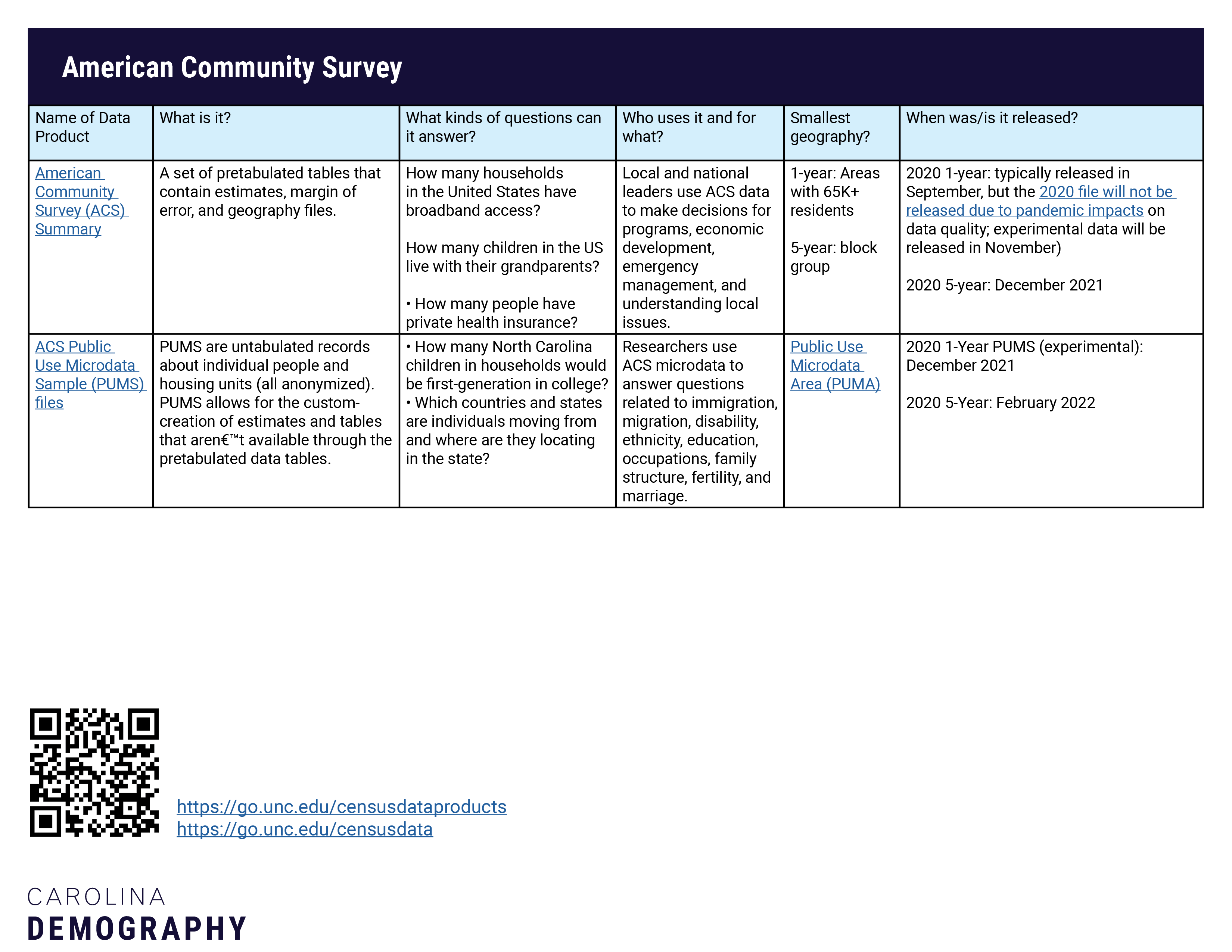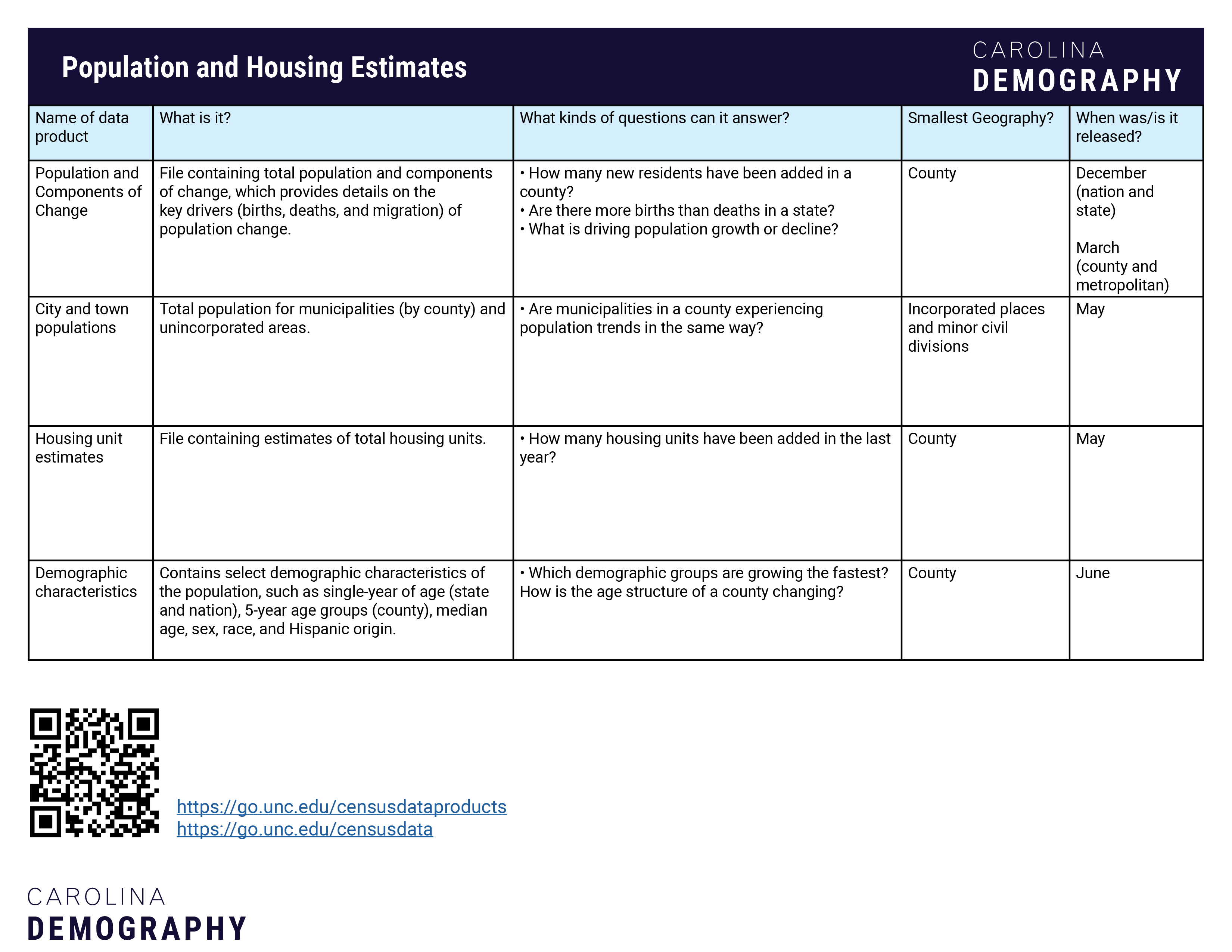Deep dive: Key Census data releases about population

In addition to the decennial census—the once-a-decade count of all persons and households in the United States—the U.S. Census Bureau regularly conducts more than 130 surveys and programs that help us understand population, housing, and business trends. Each of these programs is best-suited for specific purposes, and some of them, such as the decennial census, have multiple data products that are released at different times. In this post, we discuss the three key Census Bureau programs that tell us about population, identify key data releases associated with each product, and list the types of questions you can answer with them. These three key programs are:
Download pdfs of these data releases tables.
The 2020 Census is the official count of population and is used to apportion seats in the U.S. House of Representatives, redraw district lines during state and local redistricting, and allocate funds. It is conducted once every ten years and targets every person and household in all 50 states, the District of Columbia, and U.S. territories.
Since 2010, the decennial census has contained just a small set of questions, such as age, sex, race, Hispanic origin, and home ownership. The 2020 Census will be the official count of population and these details are available at a smaller geographic level—the census block—than is released in any other data program, though the Bureau recommends that users aggregate data to larger geographies, such as the census tract, for the 2020 release because of the new disclosure avoidance system that is being used.
There are a number of 2020 Census data products that are released. Many of them are specifically to support redistricting efforts; these products are often referred to as public law or P.L. 94-171 files.
The congressional districts used in the PL 94-171 file will be from the 113th and 116th Congress, which are not the most current boundaries for North Carolina.
| Name of Data Product | What is it? | What kinds of questions can it answer? | Who uses it and for what? | Smallest geography? | When was/is it released? |
|---|---|---|---|---|---|
| 2020 Census P.L. 94-171 Geographic Products | Detailed maps, block assignment files, and tabulation block crosswalks | How have census geographies changed over time? | Analysts, local planners, and redistricters use these files to prepare for redistricting and compile historic census data into current geographies. | Block (layout files) | February 12, 2021 |
| Apportionment Counts | This is the first release of the 2020 Census and consists of the resident population of all 50 states plus overseas federal employees (military and civilian) and their dependents who are included in their home states. | How many people live in North Carolina? How many military federal employees live overseas? How many congressional seats does each state receive? | State | April 26, 2021 | |
| Redistricting File (P.L. 94-171) | This data product will be the first file released to include demographic and housing characteristics about detailed geographic areas. Subjects include: Housing unit counts, Occupancy status for housing units (occupied or vacant), Population totals, Population totals by race, Population totals by race and Hispanic/Latino origin, Voting-age population (age 18+) by race and by race and Hispanic/Latino origin, Population totals in group quarters by major type | How many Hispanic people live in North Carolina? How many people in NC are age 18 or over? What is the population of my county? | Governors and legislative leadership in each of the 50 states use this product for redistricting purposes. | Block | Legacy format: August 12, 2021 at 1 p.m. ET Easy-to-use format with support products: by September 30, 2021 |
| Demographic Profile (DP) | Provides select demographic and housing characteristics about local communities. Subjects include: 5-year-age groups, sex, race, Hispanic or Latino origin, household type, relationship to householder, group quarters population, housing occupancy, housing tenure | What is the median age of the population? How many households in my city have children? What is the home ownership rate in my town? | Local leaders use the data to provide an understanding of how their communities have changed in key ways. | Place | TBD. After PL 94-171 files are released |
| Demographic and Housing Characteristics File (DHC) | Includes many of the demographic and housing tables that were previously in Summary File 1, including: single-year of age, sex, race, Hispanic or Latino origin, household type, family type, relationship to householder, and housing details. Some subjects are provided for major race/ethnicity groups. | How many individuals 100 or over live in my community? How many households have cohabiting partners? What proportion of married couples are same-sex couples? | Block (not available for all tables) | TBD. Generally after Demographic Profiles are released |

The American Community Survey (ACS) is an ongoing survey that is sent to a sample of ~3.5 million households across the United States and Puerto Rico on a monthly basis. The survey asks about topics that aren’t on the census, such as: educational attainment, Internet access, transportation, and employment. The ACS data is released annually for all geographies:
The ACS is best used for understanding population characteristics (percents, means, medians, and rates) rather than population counts.
| Name of Data Product | What is it? | What kinds of questions can it answer? | Who uses it and for what? | Smallest geography? | When was/is it released? |
|---|---|---|---|---|---|
| American Community Survey (ACS) Summary Files | A set of pretabulated tables that contain estimates, margin of error, and geography files. | How many households in the United States have broadband access? How many children in the US live with their grandparents? How many people have private health insurance? | Local and national leaders use ACS data to make decisions for programs, economic development, emergency management, and understanding local issues. | 1-year: Areas with 65K+ residents 5-year: block group | 2020 1-year: typically released in September, but the 2020 file will not be released due to pandemic impacts on data quality; experimental data will be released in November) 2020 5-year: December 2021 |
| ACS Public Use Microdata Sample (PUMS) files | PUMS are untabulated records about individual people and housing units (all anonymized). PUMS allows for the custom-creation of estimates and tables that aren’t available through the pretabulated data tables. | How many North Carolina children in households would be first-generation in college? Which countries and states are individuals moving from and where are they locating in the state? | Researchers use ACS microdata to answer questions related to immigration, migration, disability, ethnicity, education, occupations, family structure, fertility, and marriage. | Public Use Microdata Area (PUMA) | 2020 1-Year PUMS (experimental): December 2021 2020 5-Year: February 2022 |

The U.S. Census Bureau also produces annual population and housing estimates based on administrative records, such as birth and death certificates. The population estimates contain data on:
The population estimates are the official count of population totals and basic characteristics in the years between the decennial censuses.
| Name of data product | What is it? | What kinds of questions can it answer? | Smallest Geography? | When was/is it released? |
|---|---|---|---|---|
| Population and Components of Change | File containing total population and components of change, which provides details on the key drivers (births, deaths, and migration) of population change. | How many new residents have been added in a county? Are there more births than deaths in a state? What is driving population growth or decline? | County | December (nation and state) March (county and metropolitan) |
| City and town populations | Total population for municipalities (by county) and unincorporated areas. | Are municipalities in a county experiencing population trends in the same way? | Incorporated places and minor civil divisions | May |
| Housing unit estimates | File containing estimates of total housing units. | How many housing units have been added in the last year? | County | May |
| Demographic characteristics | Contains select demographic characteristics of the population, such as single-year of age (state and nation), 5-year age groups (county), median age, sex, race, and Hispanic origin. | Which demographic groups are growing the fastest? How is the age structure of a county changing? | County | June |

Download complete PDF of tables with links to Census data products
Need help understanding population change and its impacts on your community or business? Carolina Demography offers demographic research tailored to your needs.
Contact us today for a free initial consultation.
Contact UsCategories: Census 2020

The Center for Women’s Health Research (CWHR) at the University of North Carolina School of Medicine released the 12th edition of our North Carolina Women’s Health Report Card on May 9, 2022. This document is a progress report on the…

Dr. Krista Perreira is a health economist who studies disparities in health, education, and economic well-being. In collaboration with the Urban Institute, she recently co-led a study funded by the Kate B. Reynolds Foundation to study barriers to access to…

Our material helped the NC Local News Lab Fund better understand and then prioritize their funding to better serve existing and future grant recipients in North Carolina. The North Carolina Local News Lab Fund was established in 2017 to strengthen…
Your support is critical to our mission of measuring, understanding, and predicting population change and its impact. Donate to Carolina Demography today.